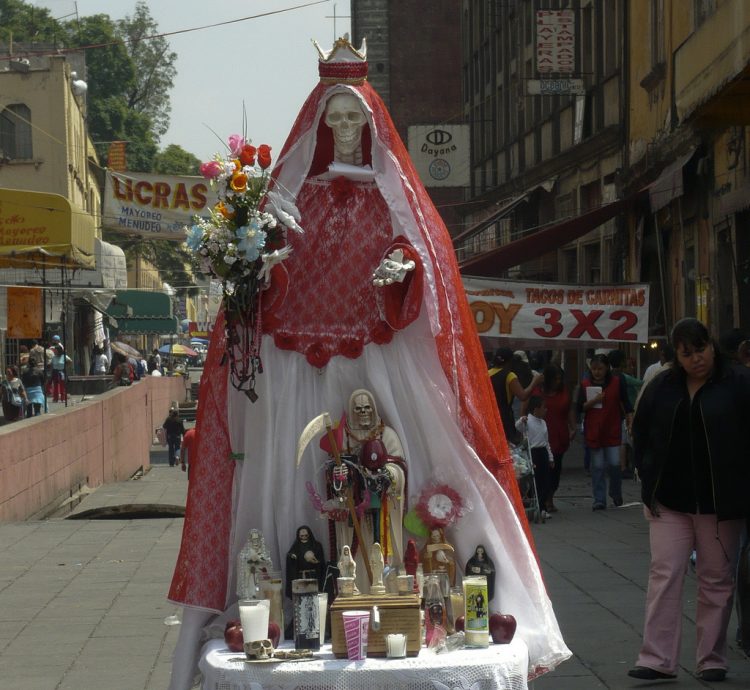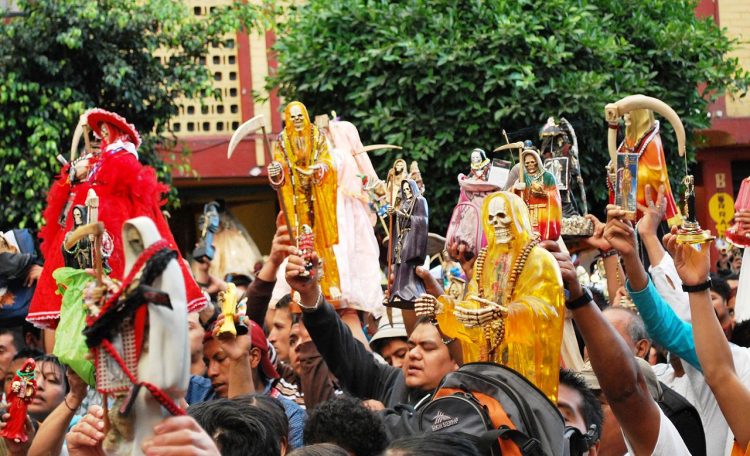Her name is Santa Muerte, the folk Saint of Death, and she is the skeletal figurehead of one of the fastest growing religions in Mexico and Central America with an estimated 10-12 million followers. Devotees have begun incorporating the controversial saint into Day of the Dead celebrations in recent years, as both are thought to originate from the Aztec goddess Mictecacihuat, or Lady of the Dead, who reigned over a festival of death every year in August.
Santa Muerte, the personification of death, is typically portrayed as a skeletal figure draped in robes and veils similar to those of the Virgin Mary. She is often depicted carrying a scythe. Her appeal, according to devotees, lies in her non-judgemental nature, as death brings a fundamental equality to all people. It is also widely believed that she will grant favors and wishes in return for vows or offerings. She is most often associated with protection, healing, and financial well being, and is the only female saint of death in the Americas.

Photo: Francis Mckee
“Santa Muerte followers say that death plays no favorites. Rich or poor, powerful or peasant, death comes for everyone,” religion expert Reza Aslan wrote in an editorial for CNN. “To outsiders it may seem as though Santa Muerte devotees are worshipping death. But by embracing death, Santa Muerte believers say they are free to live their lives without fear or anxiety.”
After Spain colonized Mexico in the 16th century, they encouraged the indigenous people to honor their deceased relatives on All Soul’s Day, a Christian holiday, which lead to the eventual merging of Christian and indigenous beliefs. Santa Muerte is considered by many as the reincarnation of Mictecacihuatl, and her devotees are beginning to reclaim the Day of the Dead as her feast day. Despite Santa Muerte’s rising popularity, the saint is considered blasphemous by the Catholic Church, and in 2013 she was officially denounced by the Vatican. The Catholic News Agency claims that Santa Muerte is a saint of criminals and the unholy, going so far as to call her demonic.

Photo: Thelmadatter
“If somebody is going to be doing something illegal, and they want to be protected from the law enforcement, they feel awkward asking God to protect them, so they promise something to Santa Muerte in exchange for being protected from the law,” Fr. Andres Gutierrez, the pastor of St. Helen parish in Rio Hondo, Texas, said. “Santa Muerte is literally a demon with another name, that’s what it is.”
Despite the harsh condemnation, Santa Muerte’s popularity only increases, particularly among the most marginalized sectors of society, such as migrants and the LGBTQ community. Santa Muerte is believed to be a protector of the LGBTQ communities in Mexico, and prayers to the saint are commonly a part of same-sex marriage ceremonies. The Iglesia Católica Tradicional México-Estados Unidos, also known as the Church of Santa Muerte, recognizes same-sex marriage and performs religious wedding ceremonies for couples.***The traditional Catholic Church condemns same-sex unions, as homosexuality is considered by the Vatican to be a disorder and an intrinsic moral evil. Given the Catholic Church’s similar stances on Santa Muerte and the LGBTQ community, it is almost inevitable that the former would come to serve as a symbol for the latter.
According to followers, the condemnation of the Saint by the Catholic Church shows a fundamental lack of understanding for what she truly symbolizes.
“It’s a widely misunderstood faith. It’s not a satanic Mass,” Daniel Santana, a lifelong believer who has officiated at Santa Muerte temples across Mexico since 2010, told the BBC. “She gives people what they want and when they finish their cycle of life here on earth she comes for their souls. She’s just fulfilling God’s orders.”
With so many social categories ignored by both the state and the church, it’s really no wonder that more and more people are turning to Santa Muerte, a pariah, just like them, for protection. Even though she stared out as a mere folk figure in Mexico, the popularity of Santa Muerte has been soaring over the last two decades, and she now has followers all over Central America and even in the United States.






